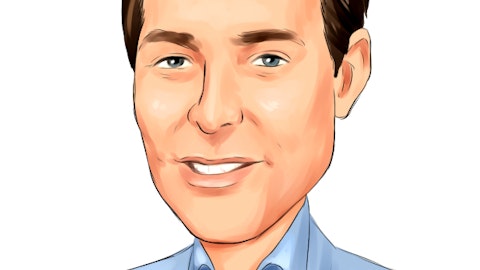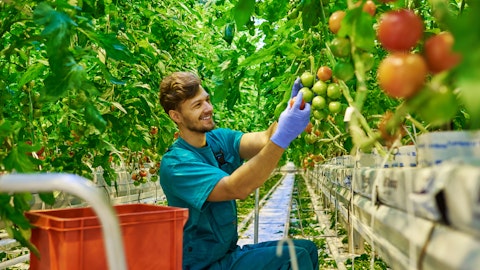Jean-Christophe Flatin: Thank you, Andrew. JC here. I’ll take this one. Clearly, the way we have guided today is the outcome of our budgeting process. If you say what have you been doing since we last spoke, one of the things we did was projecting, which is evaluating scenarios in the light of the business context. We have the choice to go for profit only, but this is not in line with our North Star, which is profitable growth, because it could have impaired the future growth potential of this business. As I’ve explained, when we boil it down to answer your question, the main drivers of this guidance. First, it is an immense turnaround journey to reduce $220 million loss of adjusted EBITDA in two years. Second, we really wanted to protect healthy growth investments to capture the massive growth potential that we believe we have. And finally, taking into account really the diverse situation of all three segments. In a nutshell, boiling down, this is what drove us.
Operator: Our next question comes from Max Gumport with BNP Paribas. Please proceed.
Max Gumport: Thanks for the question. One quickly on Americas. It sounds like foodservice in Americas revenue was up 4.5%. Total Americas up 2%. It would imply not much growth for U.S. retail. In the scanner data, at least we’re seeing for the milk business, it’s up mid-single-digits or better in 4Q. I just wanted to make sure we are not missing anything in terms of non-track channel impacts or inventory dynamics that held back U.S. retail revenue in 4Q? Thanks.
Daniel Ordonez: Thank you, Max. Good morning. Daniel here. Yes, I will go straight into your question. What you see is the net effect of the slotting fees in quarter four, Max. As you saw, there is a very heavy NPD innovation agenda that the teams are working on starting at the end of last year, beginning of this year with some very exciting new listings and that’s the impact. You can see there in the volume growth and you can see in the very exciting market data that I’m sure you’ve seen on January 30. Listen, we are seeing TDPs off the chart at 50% growth, ACV at 43% and growing. Remember, a year ago, we were at 34%, three-four and with room to grow. So record market shares and really very, very nice dynamics in top-line growth. In our core wholesale business about 10%. So positive outlook and the net effect of the slotting fees that’s what we can add, Max.
Max Gumport: Great. Makes sense. And then a year ago, you laid out your expectation to achieve a high 20% gross margin this quarter. Obviously, the business has changed quite a bit. The strategy has changed. Looking at the bridges you provided over the last year, it seems like one headwind that’s been larger than you might have expected a year ago was the trade promotion and mix trend that you had it. Just hoping you could expand on why this played out a bit differently than expected and also what this means for gross margin in ’24? I’ll leave it there. Thanks very much.
Marie-Jose David: So look, when we look at where we landed for gross profit, there is no anything structural or any pull out. As a reminder, when we changed our margin guidance last quarter from high 20 to mid-20, it was driven by the expected cost related to the execution of our reset plan in China, mainly from this true rationalization as we mentioned, combined with the impact from the foodservice mix in the U.S. So both elements somehow came slightly different from our forecast. But as I said, there is, as we see nothing structured here. I mean, we said it right and [indiscernible] mentioned it, there is a gross margin as a key lever to deliver on our North Star, and I’m very confident on 2024.
Operator: Our next question comes from John Baumgartner with Mizuho Securities.
John Baumgartner: First off, I wanted to come back to the impairment charge in Q4. I’m not entirely clear what happened there. The press release noted certain events that resulted in discontinued construction? Can you disclose the events that happened? Like what drove the charge? Is there a pivot from here similar to another sort of Ya Ya agreement in your future? Any comments would be helpful.
Jean-Christophe Flatin: Let me take the context point. Honestly, what you see in the impairment chart for Q4 is only, and I insist only the execution of the discontinuation of the U.S. and EMEA factory we announced in the Q3 call. Nothing new, nothing different.
John Baumgartner: Second question for Daniel, if I could. Going back to Slide 14 and the innovation there in EMEA, I guess it was the Jigger, the Mini, the 1 liter, the 1.5 liter. It feels as though you’re introducing a lot more complexity into the portfolio. And I think that’s the ice cream and frozen dessert strategy in Asia, and how complexity there impacting the business and profitability. Can you speak to the complexity in EMEA? I mean, are these products produced internally? Are they profitable? I’m just wondering at what point the complexity becomes more of a headwind than a revenue opportunity for you?
Daniel Ordonez: Fantastic, John. Well, thank you. That’s a great question. Well, two ways in which I would approach that question, John. First, from a consumer standpoint and from a revenue pool, from growth space standpoint, we’re doubling down on the range, the Barista addition, which is what really pretty much define the rules of the game, in plant-based and in oat milk. So what you see here, since you made a comparison versus China, there is nothing similar to what we have resetted in China. This is doubling down vertically. Allow me to use this geometrical metaphor on what’s working for us. So it’s more occasions and more spaces and more cultural spaces for our coffee moments. That’s incremental growth in different spaces.



